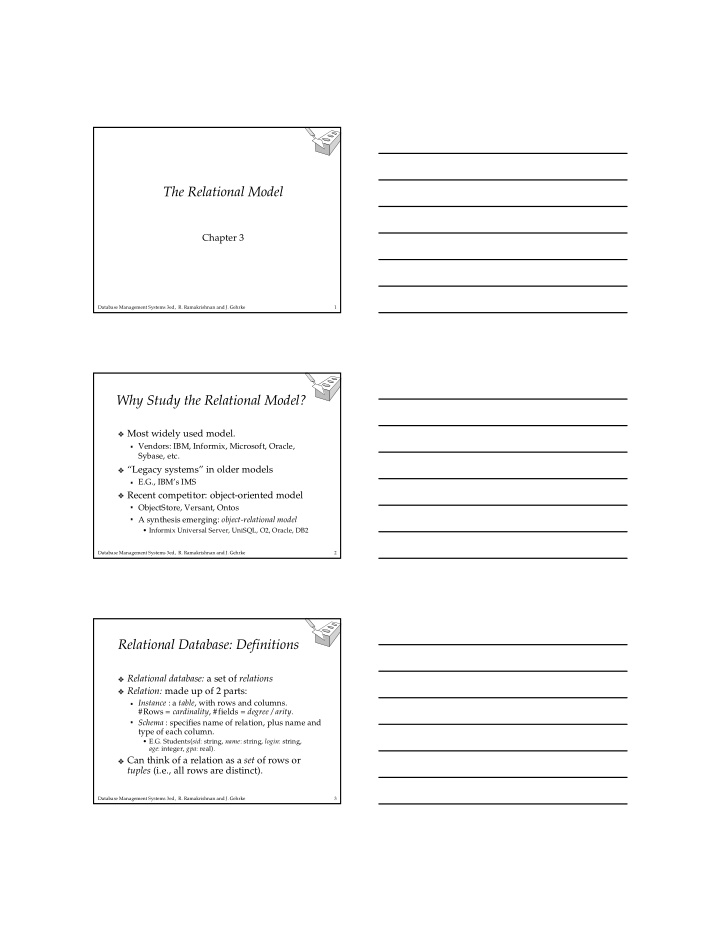



✁ ✁ � ✁ ✁ � � ✁ � ✁ � � The�Relational�Model Chapter�3 Database�Management�Systems�3ed,��R.�Ramakrishnan�and�J.�Gehrke 1 Why�Study�the�Relational�Model?� Most�widely�used�model. Vendors:�IBM,�Informix,�Microsoft,�Oracle,� Sybase,�etc. “Legacy�systems”�in�older�models� E.G.,�IBM’s�IMS Recent�competitor:�object-oriented�model ObjectStore,�Versant, Ontos A�synthesis�emerging:� object-relational�model • Informix�Universal�Server, UniSQL,�O2,�Oracle,�DB2 Database�Management�Systems�3ed,��R.�Ramakrishnan�and�J.�Gehrke 2 Relational�Database:�Definitions Relational�database: a�set�of� relations Relation: made�up�of�2�parts: Instance :�a� table , with�rows�and�columns.� #Rows�=� cardinality ,�#fields�=� degree�/ arity. Schema� : specifies name�of�relation,�plus�name�and� type�of�each�column. • E.G.�Students( sid :�string,� name :�string,� login :�string,������������������������ age :�integer, gpa :�real). Can�think�of�a�relation�as�a� set of�rows�or tuples (i.e.,�all�rows�are�distinct). Database�Management�Systems�3ed,��R.�Ramakrishnan�and�J.�Gehrke 3
✁ ✁ � ✁ ✁ ✁ � ✁ � � � � � Example�Instance�of�Students�Relation sid� name� login� age� gpa� 53666� Jones� jones@cs� 18� 3.4� 53688� Smith� smith@eecs� 18� 3.2� 53650� Smith� smith@math� 19� 3.8� � � Cardinality�=�3,�degree�=�5,�all�rows�distinct Do�all�columns�in�a�relation�instance�have�to be�distinct? Database�Management�Systems�3ed,��R.�Ramakrishnan�and�J.�Gehrke 4 Relational�Query�Languages A�major�strength�of�the�relational�model:� supports�simple,�powerful� querying of�data.� Queries�can�be�written�intuitively,�and�the� DBMS�is�responsible�for�efficient�evaluation. The�key:�precise�semantics�for�relational�queries. Allows�the�optimizer�to�extensively�re-order� operations,�and�still�ensure�that�the�answer�does� not�change. Database�Management�Systems�3ed,��R.�Ramakrishnan�and�J.�Gehrke 5 The�SQL�Query�Language Developed�by�IBM�(system�R)�in�the�1970s Need�for�a�standard�since�it�is�used�by�many� vendors Standards:� SQL-86 SQL-89�(minor�revision) SQL-92�(major�revision) SQL-99�(major�extensions,�current�standard) Database�Management�Systems�3ed,��R.�Ramakrishnan�and�J.�Gehrke 6
� � � � The�SQL�Query�Language To�find�all�18�year�old�students,�we�can�write: sid name login age gpa SELECT� * FROM Students�S 53666 Jones jones@cs 18 3.4 WHERE S.age=18 53688 Smith smith@ee 18 3.2 •To�find�just�names�and�logins,�replace�the�first�line: SELECT S.name,�S.login Database�Management�Systems�3ed,��R.�Ramakrishnan�and�J.�Gehrke 7 Querying�Multiple�Relations What�does�the�following�query�compute? SELECT� S.name,�E.cid FROM Students�S,�Enrolled�E WHERE S.sid=E.sid AND E.grade=“A” Given�the�following�instance� sid cid grade 53831 Carnatic101 C of�Enrolled�(is�this�possible�if� 53831 Reggae203 B the�DBMS�ensures�referential� 53650 Topology112 A integrity?): 53666 History105 B S.name� E.cid� we�get: Smith� Topology112� � � Database�Management�Systems�3ed,��R.�Ramakrishnan�and�J.�Gehrke 8 Creating�Relations�in�SQL Creates�the�Students���������� CREATE�TABLE�Students relation.�Observe�that�the�������� (sid:� CHAR(20) ,� name:� CHAR(20) ,� type�(domain)��of�each�field��������� login:� CHAR(10), is�specified,�and�enforced�by����� age:� INTEGER , the�DBMS�whenever tuples gpa:� REAL )�� are�added�or�modified.� As�another�example,�the��� CREATE�TABLE�Enrolled Enrolled�table�holds���� (sid:� CHAR(20) ,� information�about�courses������� cid:� CHAR(20) ,� that�students�take. grade:� CHAR (2))�� Database�Management�Systems�3ed,��R.�Ramakrishnan�and�J.�Gehrke 9
✁ ✁ ✁ � ✁ � � � � � � Destroying�and�Altering�Relations DROP�TABLE�� Students� Destroys�the�relation�Students.��The�schema� information� and the tuples are�deleted. ALTER�TABLE�� Students� ADD�COLUMN firstYear:�integer The�schema�of�Students�is�altered�by�adding�a� new�field;�every tuple in�the�current�instance� is�extended�with�a� null value�in�the�new�field. Database�Management�Systems�3ed,��R.�Ramakrishnan�and�J.�Gehrke 10 Adding�and�Deleting Tuples Can�insert�a�single tuple using: INSERT�INTO�� Students�(sid,�name,�login,�age, gpa) VALUES (53688,�‘Smith’,�‘smith@ee’,�18,�3.2) Can�delete�all tuples satisfying�some� condition�(e.g.,�name�=�Smith): DELETE FROM Students�S WHERE S.name�=�‘Smith’ * Powerful�variants�of�these�commands�are�available;�more�later! Database�Management�Systems�3ed,��R.�Ramakrishnan�and�J.�Gehrke 11 Integrity�Constraints�(ICs) IC: condition�that�must�be�true�for� any� instance� of�the�database;�e.g.,� domain�constraints. ICs�are�specified�when�schema�is�defined. ICs�are�checked�when�relations�are�modified. A� legal instance�of�a�relation�is�one�that�satisfies� all�specified�ICs.�� DBMS�should�not�allow�illegal�instances. If�the�DBMS�checks�ICs,�stored�data�is�more� faithful�to�real-world�meaning. Avoids�data�entry�errors,�too! Database�Management�Systems�3ed,��R.�Ramakrishnan�and�J.�Gehrke 12
� ✁ � � ✁ � � ✁ � ✁ � ✁ Primary�Key�Constraints A�set�of�fields�is�a� key for�a�relation�if�: 1.�No�two�distinct tuples can�have�same�values�in�all� key�fields,�and 2.�This�is�not�true�for�any�subset�of�the�key. Part�2�false?�A superkey . If�there’s�>1�key�for�a�relation,�one�of�the�keys�is� chosen�(by�DBA)�to�be�the� primary�key . E.g., sid is�a�key�for�Students.��(What�about� name ?)��The�set�{ sid, gpa }�is�a superkey. Database�Management�Systems�3ed,��R.�Ramakrishnan�and�J.�Gehrke 13 Primary�and�Candidate�Keys�in�SQL Possibly�many� candidate�keys (specified�using� UNIQUE ),�one�of�which�is�chosen�as�the� primary�key . CREATE�TABLE Enrolled “For�a�given�student�and�course,� (sid CHAR (20) there�is�a�single�grade.”�vs.� cid�� CHAR(20) , “Students�can�take�only�one� grade� CHAR (2), course,�and�receive�a�single�grade� PRIMARY�KEY�� (sid,cid)�) for�that�course;�further,�no�two� students�in�a�course�receive�the� CREATE�TABLE Enrolled same�grade.” (sid CHAR (20) cid�� CHAR(20) , Used�carelessly,�an�IC�can�prevent� grade� CHAR (2), the�storage�of�database�instances� PRIMARY�KEY�� (sid), that�arise�in�practice! UNIQUE (cid,�grade)�) Database�Management�Systems�3ed,��R.�Ramakrishnan�and�J.�Gehrke 14 Foreign�Keys,�Referential�Integrity Foreign�key :�Set�of�fields�in�one�relation�that�is�used� to�`refer’�to�a tuple in�another�relation.��(Must� correspond�to�primary�key�of�the�second�relation.)�� Like�a�`logical�pointer’. E.g. sid is�a�foreign�key�referring�to�Students: Enrolled( sid :�string,� cid :�string,� grade :�string) If�all�foreign�key�constraints�are�enforced,�� referential� integrity is�achieved,�i.e.,�no�dangling�references. Can�you�name�a�data�model�w/o�referential�integrity?� • Links�in�HTML! Database�Management�Systems�3ed,��R.�Ramakrishnan�and�J.�Gehrke 15
Recommend
More recommend